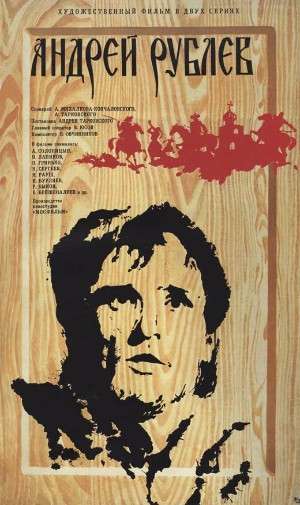Andrei Rublev

Andrei Rublev (or "The Passion According to Andrei") is a 1966 film by Andrei Tarkovsky, loosely based on the life of Russia's famous icon painter of the same name. It is the movie that launched the director to international attention after its warm reception at the Cannes film festival.
The movie is notable for its troubled production and numerous issues with the Soviet Union's strict censorship board. It is Tarkovsky's longest and most violent film, and was only available in heavily cut versions until the Criterion Collection DVD release in 1999, which restored the film to its original 205 minute run time.
As with most Tarkovsky films, it eschews a traditional narrative structure, relying on episodic vignettes that take place around the life of Rublev, with the man himself often taking a backseat to the actions on screen depicting the time. Interestingly, the film never once depicts Andrei Rublev painting, and is entirely in black and white until an ending montage of Rublev's work in blazing color. It is quite depressing, but also considered to be a shining example of one of the 20th century's greatest creative minds at the height of his power.
- Art Shift: The film finally goes colorful at the end.
- The Atoner: Andrei, after killing a man in defense of Durochka.
- Author Avatar: Andrei Rublev himself struggles with many of the same crises of faith and art that Tarkovsky did
- Non Sequitur Scene: The film opens with a mob attacking a man who is trying to create a flying machine. The machine takes off, crashes, and kills its driver. This incident is never referenced again.
- Biopic: Averted. While the film does fall into this genre, the movie is actually ABOUT the relationship between art and faith, not Andrei Rublev's life.
- Crapsack World: Medieval Russia, evidently, was not fun
- Crowning Moment of Awesome: The great church bell is ringing!
- Deliberately Monochrome: Though black and white film was probably used to partially save money on a long and extravagant film, it was not a necessity demonstrated by the ending montage
- Eye Scream: Getting your eyes gouged out by someone's spurs counts.
- The Fool: Durochka
- Gorn: Quite potent for a film of the period. There's a cow being set on fire, and a horse with a broken leg getting rolled down a flight of stairs. (Did I mention that, in context, that's actually kind of the comic relief?)
- Informed Ability: Rublev is never, ever shown actually picking up a brush to paint
- Innocent Fanservice Girl: Averted with Durochka
- Le Film Artistique: a shining example.
- Meaningful Name: "Durochka" means "little fool."
- The Middle Ages: A very accurate and unflinching depiction
- No Animals Were Harmed: Mostly played straight, with one unfortunate aversion. One scene depicts the real death of a horse which had been purchased by the filmmakers from a slaughterhouse.
- according to other evidences a cow has been burned alive on the set.
- The cow was wearing a fireproof blanket, to make it look like it was burning alive when it actually wasn't. The horse, though—that one was real.
- Old Master: Theophanes the Greek
- The Plague: Killed the parents of Boriska
- Scenery Porn
- Screw This, I'm Outta Here: Fellow monk Kirill, after losing a prominent commission to Andrei.
- True Art Is Angsty: And HOW.[context?]
- True Art Is Incomprehensible
- What Do You Mean Its Not Symbolic?